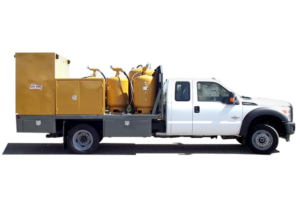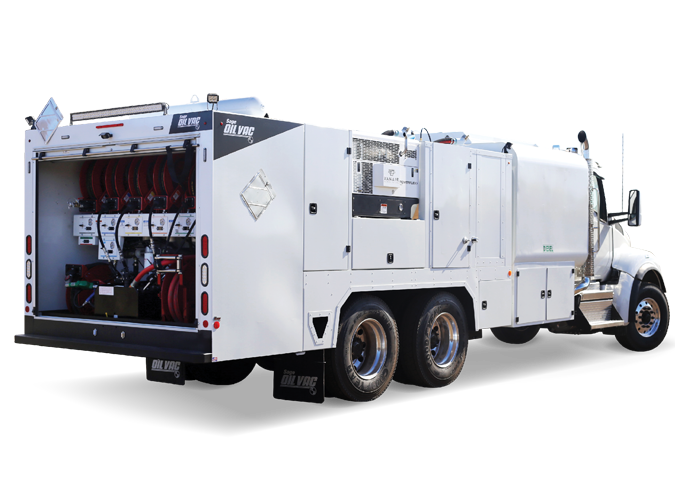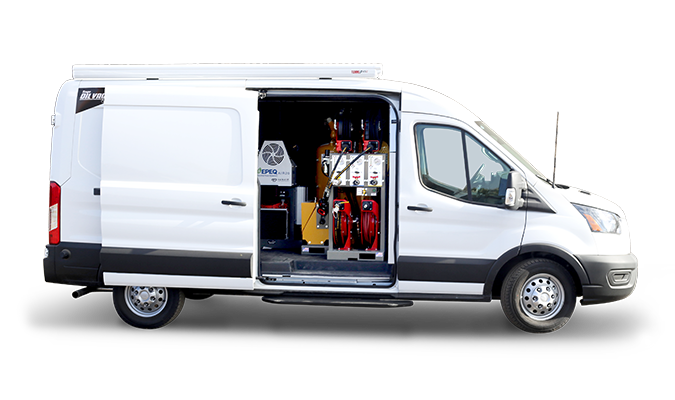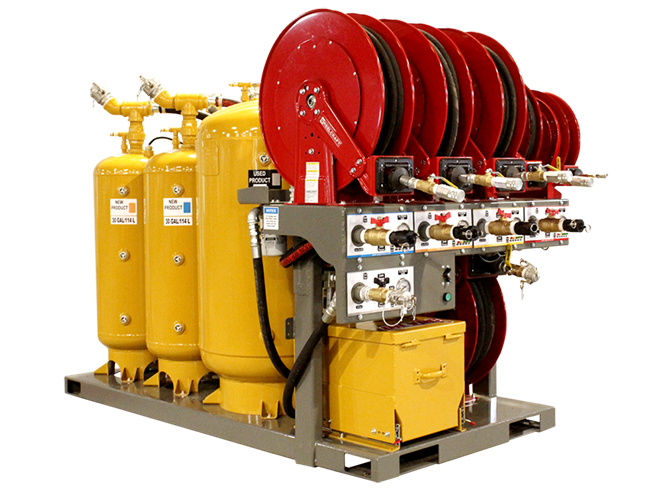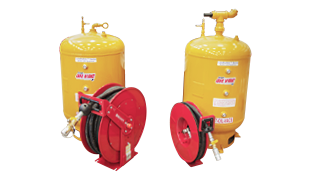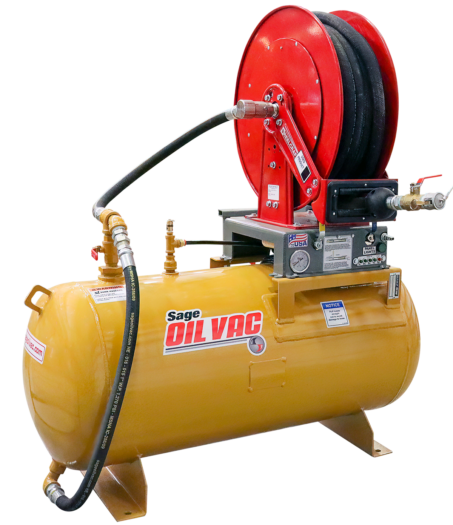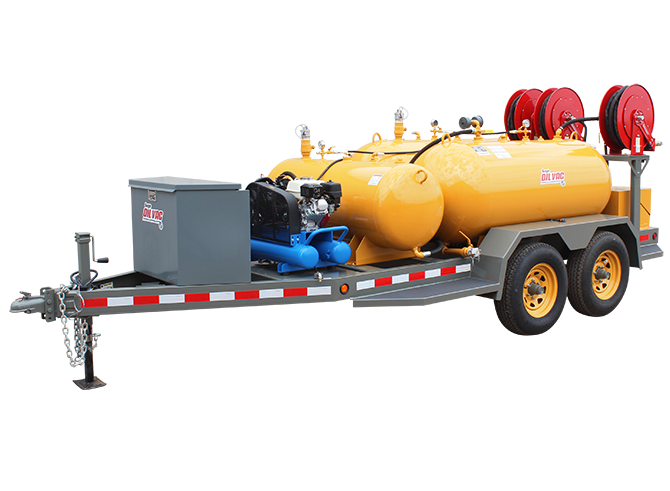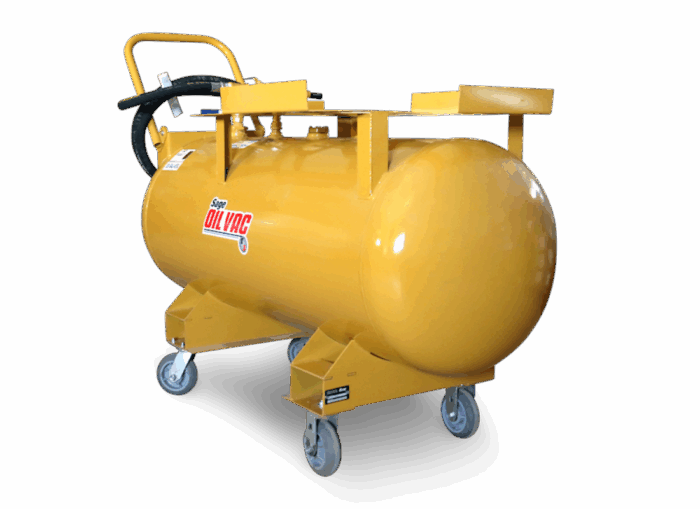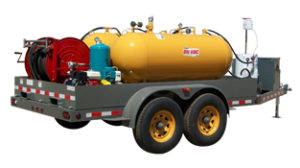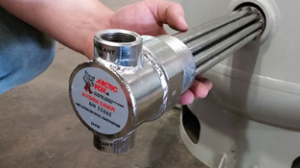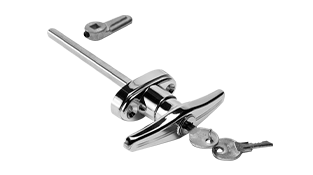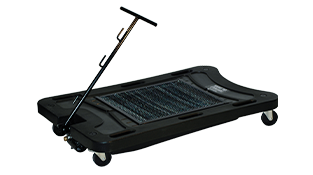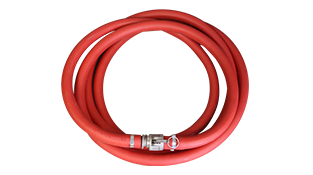Job sites don’t just come to a halt because of cold weather. But changing the oil in a piece of machinery outside — on the job site, on the farm or in the field — in the dead of winter is no fun.
But a cold weather oil change has to be done, and with the right procedures and equipment, managing oil and fluids during the cold winter months doesn’t have to be such a challenge.
Maintenance when the temperature drops
It all starts with temperature. Just like you bundle up to head outside when the temperature dips, any cold weather oil change has to happen at the right time to be effective and prevent long-term engine damage.
Temperature is what makes changing oil more difficult during the winter, and it is temperature that you need to be most attentive to in the entire process, according to Sage Oil Vac CEO Aaron Sage. He recommends performing an oil change within minutes of engine shutdown after operating at normal temperatures.
“If you’re in the field in fall or winter, the best thing is to have the operator pull up to the oil change site and do the oil change within the next five minutes while the engine is warm,” he said. “You can’t go to a job site where the equipment’s been sitting for 10 days without doing anything, then do the oil change. It’s stone-cold and all the contaminants in that oil are settled on engine parts. Simply pulling the plug then is not going to yield a good oil change.”
Even though heat can sometimes be dangerous when changing oil using conventional equipment, most experienced technicians know it’s important to get the engine warm so oil is viscous enough to drain. But there’s more to it than that; the functionality of engine oil declines in cold temperatures.
“It’s not only viscosity but the position of the oil and the suspension of the minerals in that oil,” Sage said. “That oil is there to clean wear metals and get contaminants off moving parts and suspend them in the oil, and they’re usually suspended equally in the oil. If you run the engine to warm it up, then shut it off, those contaminants are going to settle out in the bottom of the pan, on valves and pistons and other parts.”
Assembling the right system
The ideal scenario for a cold weather oil change is to change the engine oil when it is near operating temperature, viscous enough to remove contaminants so they don’t inflict further damage to engine parts. However, handling hot oil can be dangerous and difficult, making the right facilities, tools and equipment critical to doing the job effectively and safely.
“If you know you’re going to be changing oil in the winter, you really need to have quick disconnects on your oil pans. It’s really helpful to have those to close the loop with the crankcase,” Sage said. “Some drain into buckets because they have a mindset of ‘That’s the way granddad did it, and that’s how we’re going to do it.’ A Sage Oil Vac system eliminates the need to deal with buckets and helps get the job done at optimal temperatures, even when they’re far from optimal outside.”
A heated fluid tank can help, too. Sage Oil Vac heated tanks use immersion heaters that use standard coolant fluid and probes inside the tank to transfer heat to the oil. Leveraging a tool like this can enable operators to more easily change oil in cold winter conditions at optimal temperatures.
“Some say they take their machinery into the shop where they have an oil pit and temperature can be better controlled. But that shop might be 70 miles away from the job site, so they may lose two days of production,” Sage said. “Time is money, and a Sage Oil Vac system and heated fluid tanks will pay for themselves quickly, especially when you take engine loss into account.”
In addition to the effectiveness of changing oil at the right temperatures, and the convenience and cleanliness of using a Sage Oil Vac system, there’s a cost benefit, too. Many choose to change engine oil inside a heated shop or building during cold winter months. But that can quickly erode revenue potential, especially when the machinery is integral to a job site’s overall operation.
Cold weather maintenance in action
Cold weather oil changes are a convergence of circumstances for Tom Fisher, product support manager for Plasterer Equipment Company, Inc. The 107-year-old John Deere construction, forestry and commercial equipment dealership with four locations around southeast Pennsylvania provides service to contractors around the region, where no one is a stranger to operating in winter conditions.
The region is far enough from the Great Lakes to avoid treacherous conditions like lake-effect snowfall during the winter, but low temperatures from December through March commonly dip into the 20s, with daytime highs averaging from the mid 30s to upper 40s. At those temperatures, oil begins to flow slowly because of increased viscosity, something that can hinder jobsite equipment maintenance operations, Fisher said. Efficiently serving such a diverse customer base can become a challenge when winter weather conditions cause operations to slow down. The effort to overcome that challenge was the start for Plasterer to begin working with Sage Oil Vac.
Plasterer Equipment initially started with a truck cab and chassis, then added the Sage LubeBuilder™ system and constructed an enclosure box around the oil change equipment. The team was able to integrate the system into an existing service truck that could meet specific service goals efficiently and at a lower cost, even in cold, snowy winter conditions.
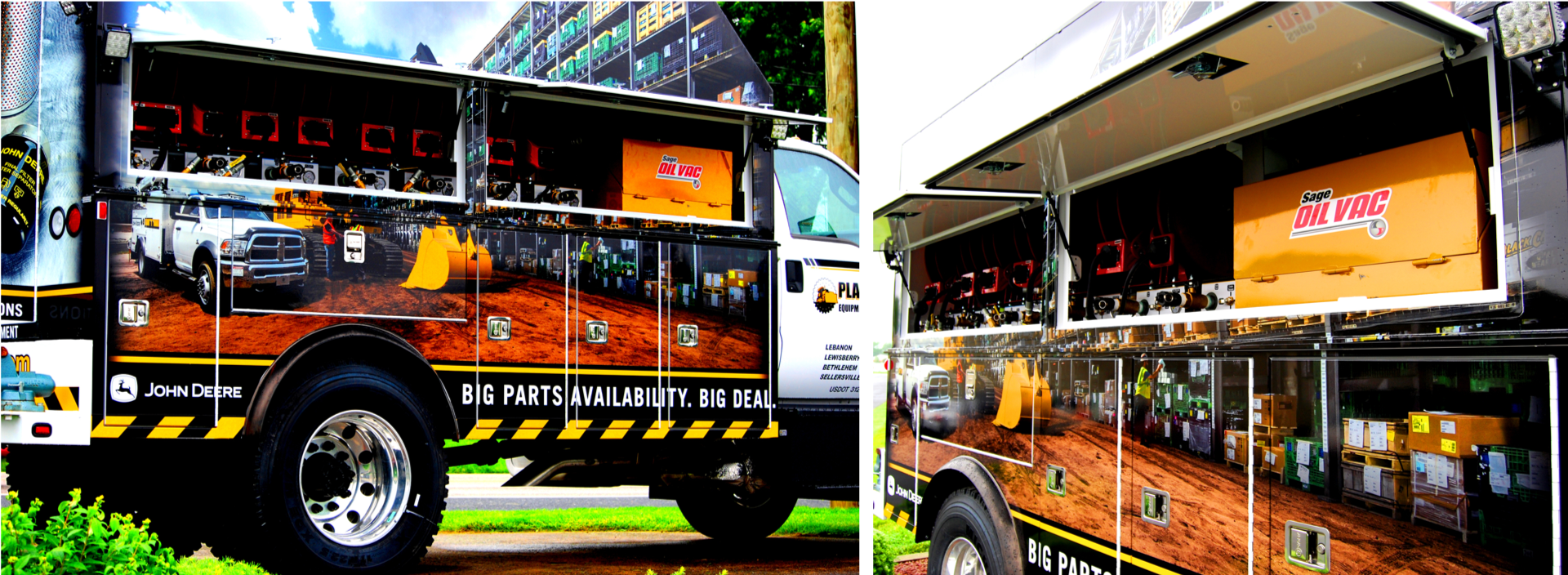
The main motivation of Plasterer Equipment to integrate a Sage system into mobile lubrication service was a combination of the ability to provide efficient, timely service — including in cold, snowy winter weather — without the undue higher operating costs associated with a larger service truck with capabilities beyond the company’s customer needs. “We’ve always offered preventative maintenance services and regular lubrication services to customers with regular service trucks. We discussed a new truck internally, did a lot of research and decided to go with a Sage system that could give us the lube service capabilities to perform all the routine preventative maintenance our customers need,” Fisher said.
According to Fisher, the company is in the process of building a second lube truck, with an ultimate goal of having four units, one providing mobile lube service from each of Plasterer’s four locations.
Sage is excited to announce our placement among the top 100 companies from around the world selected for the 15th annual Aggie 100. The Aggie 100 honors the fastest-growing companies owned or operated by former students of Texas A&M University.
“We are incredibly honored and humbled to be named as a 2019 Aggie 100 honoree,” said Sage CEO Aaron Sage. “Our team has put in a lot of collective hard work to reach this stage in our annual growth rate and it’s exciting to see it recognized in an official capacity.”
The 100 Aggie-owned companies with the highest compound annual revenue growth from 2016 to 2018 were recognized at a formal celebration at the Hall of Champions at Texas A&M University’s Kyle Field on Friday, Oct. 25, 2019. Sage was recognized as number 88 with a compound annual growth rate of 32.6%.
“As we mark the 15th Crystal Anniversary of the Aggie 100 program, we celebrate our success by raising up the newest class of Aggie 100 honorees,” said Blake Petty, director of the McFerrin Center for Entrepreneurship. “Knowing how each member company of the Class of 2019 has overcome their own adversities to reach astounding levels of growth and prosperity, we dedicate this significant milestone to the excellence exhibited by our newest additions to the Aggie 100 family.”
A complete Aggie 100 list can be viewed at aggie100.com.

The team at Rabern Rentals don’t consider themselves too tech-savvy or earlier adopters of the industry’s latest advancements. They are just hard-working, practical people who want to provide quality service to customers and be diligent about maintaining their equipment fleet. So when they discover a good idea, whether at their local American Rental Association chapter meeting, a trade show or from a fellow rental store owner, they implement it only if it aligns with those two values.
With two locations in Amarillo and one in Hereford, Texas, Rabern Rentals Owner Steve Berner said their team is always looking for a better way to manage and maintain Rabern Rentals’ rental fleet. “We classify ourselves as heavy equipment people — any contractors looking for large equipment that typically isn’t stocked at other rental stores has been an important niche for our business,” he explained. “We carry everything from large excavators and wheel loaders to forklifts and aerial equipment. Our fleet across the two stores is massive, and we regularly call on contractors who are working up to 200 miles away. Ensuring that preventative maintenance (PM) was being routinely performed is a huge undertaking, which is why we’re always looking for tools and equipment that can help simplify the process.”
Fleet service challenges
Every rental store manager and owner understands the challenges of maintaining a large rental fleet. To ensure the manufacturer-recommended PMs are performed, many rental operations rely on customers to monitor their rented equipment or make frequent trips or calls to jobsites, themselves. Others merely wait until a machine comes off rent to perform PMs, which is a recipe for downtime and costly repairs.
Rabern Rentals didn’t want to be just another rental store, which is why performing PMs on schedule has always been a priority for the team. However, to stay on top of the service intervals to its distributed rental fleet across four different states, Rabern Rentals’ service technicians have to spend a lot of time behind the wheel of a service truck traveling between jobsites.
“A typical day used to consist of loading the back of the truck up with supplies, including as many 5-gallon buckets of motor oil as I could fit, driving to a jobsite, spending a lot of time looking for the machine that needed to be serviced, performing the PM, and then cleaning up,” explained Tim Poland, service technician with Rabern Rentals. “It’s inefficient and messy, but normal for most service techs.”
Upgrading PMs
Rabern Rentals began to upgrade its PMs process a few years ago with the integration of telematics and a mobile lube system. “Many of our equipment suppliers started to offer trials of their telematics systems when we purchased new equipment,” explained Berner. “So that gave us a taste for what we could do with telematics, and after that, we began to add it to many of our larger machines. With better data, we also wanted to have a better way of performing routine maintenance, which led to us purchasing a Sage Oil Vac lube trailer. I just wanted the process to be easier on our guys and faster for the customers.”
Now for telematics, Rabern Rentals uses a mixed system that incorporates data supplied through original equipment manufacturers (OEM) telematic systems and aftermarket systems from Mix Telematics. Machine data is fed to a customized dashboard that everyone at Rabern Rentals has access to. The dashboard lets them know when a machine needs to be serviced, and with geofencing and GPS, they always know exactly where their machines are. Instead of service technicians having to wait for a customer to contact them when service needs to be done, they call the customer to let them know when they will be coming by to do it.
Poland said the Sage Oil Vac lube trailer is the perfect complement to telematics. “What good is service data if a person doesn’t have the time to perform the PMs efficiently,” he joked. “With our mobile lube trailer, we’re able to carry a lot more fluids with us to jobsites, reduce the amount of time it takes to do an oil change, more accurately measure the amount of oil we add and reduce the risk of dripping or spilling oil. It’s made a big impact on our business.”
Trailer setup
With customers spread throughout four states, traveling back and forth from Rabern Rentals facilities to drop off used oil and pick up fresh oil was a significant time waster. When spec-ing their mobile lube trailer, Berner’s staff worked with the team at Sage Oil Vac to develop a custom solution to reduce their travel times. The mobile lube tandem axle trailer includes two 250-gallon tanks — one for 15-40 fresh oil and another to hold waste oil. There are also three 30-gallon tanks on the front to carry hydraulic fluid, a grease kit and an air compressor that powers the system.
The tanks on Rabern Rentals’ mobile lube system has a pump-free design that uses vacuum technology to dispense and drain fluid. Compressed air is used to push oil out of the tank and vacuum pressure to suck up used oil into the waste tank; the service technician just needs to flip a switch to create suction. There are no moving parts inside the tanks, and the vacuum system is completely sealed. The pneumatic grease gun kit also runs off the same air compressor.
“With 500 gallons of fresh oil onboard, I can handle multiple services in a single trip, and get rid of all the buckets I used to have to carry in the back of my truck,” Poland said. “With that much oil, I can do PMs on seven wheel loaders without having to come back to the shop. And having hydraulic tanks allows me to be able to add fluid if a machine’s hydraulic system is a bit low, or when a machine blows a hose and loses a lot of fluid. Having an air-powered grease gun has also made greasing a machine a lot faster, and it has a lot more force behind it than a hand-pump gun.”
Better for everyone
The results of integrating telematics and a mobile lube trailer are positive. Rabern Rentals employs several service technicians, and they all have complete access to data from the 300+ machines in their fleet with telematics. The trailer also makes it easy for any one of them to hitch it to their service truck and go.
“The changes we’ve made have helped our team better manage and maintain our rental fleet, but that’s only part of it,” said Poland. “Equally important is we’ve been able to reduce PM downtime for our customers. With telematics, we can plan better, and with the Sage Oil Vac system, we can get the work done faster.”
Service is the difference
The high level of service customers receive from the team at Rabern Rentals is a key differentiator in a competitive rental market. “Service has allowed us to demand higher rental rates. We may be 5-10 percent higher than other places, but our customers continue to choose us because they don’t have to worry about getting poorly maintained and dirty equipment that is more prone to breakdowns. We want our customers satisfied and working, our employees safe and happy — making an investment in service has helped make all of that possible,” concluded Berner.
Time is money on the jobsite. If you’re spending too much time using conventional means to change oil on the job, it’s likely costing you money, and certainly preventing your operation from working at its peak capacity.
When we talked to Michigan-based Caterpillar heavy equipment dealer, we learned just how much productivity is gained when using a Sage mobile lube or oil system verses a traditional pump system. The company frequently changes oil in power generators and beyond so when they heard about Sage Oil Vac they were ready to give it a try. Check out the comparison below to see the full scope of Michigan CAT’s potential time savings.
Before Sage Oil Vac
Michigan CAT services and maintains a group of power generators in the lower peninsula of Michigan, a job that requires the removal and replacement of 110 gallons of oil for each machine. Using conventional means — typically comprising delivering two 55-gallon barrels of oil to the jobsite, switching out oil manually and returning barrels of used oil to a central shop — Michigan CAT service technicians averaged almost three hours per oil change.
To break the time savings down further, let’s do some math. Michigan CAT started their oil exchange process by loading two 55-gallon drums of oil into their truck before driving to the generator. The generator, which holds 110 gallons of oil, takes 55 minutes to vacuum the used oil into two empty drums. Then it takes an additional 55 minutes to pump two drums of new oil into the generator. Once this is complete, the operator returns to the shop to dump the used oil into a used oil tank which takes yet another 55 minutes. All in all, the total oil change cycle lasts a total of 165 minutes.
Jobsite time savings with Sage Oil Vac
Using a Sage 1C5F-2100 preventative maintenance (PM) trailer cut that maintenance time drastically. What took Michigan CAT techs almost three hours took just a fraction of the time.
According to Michigan CAT, the time comparison when using a Sage system was felt right out of the gate. Before leaving the shop, it took 13 minutes to fill the 1C5F-2100 PM Trailer with two drums of fresh oil. Then it took about 13 minutes to vacuum the used oil from the generator, 30 minutes to refill it with fresh oil and another 13 minutes to discard the used oil when they returned to the shop.
In all, technicians can save an average of 96 minutes per oil change start to finish. In many cases, that’s enough time to conduct at least one more oil change per day, enabling operators to create new efficiencies, service more equipment and build new business growth opportunities.
“Saving this much time per day adds up to major savings for the operator,” said Sage CEO Aaron Sage. “In addition to our systems making it easier to maintain a clean jobsite, operators can simply get more work done and get more machinery serviced every day.”
See more details about how time can be saved. Find your nearest Sage dealer to make the change and get more from your time on the jobsite.
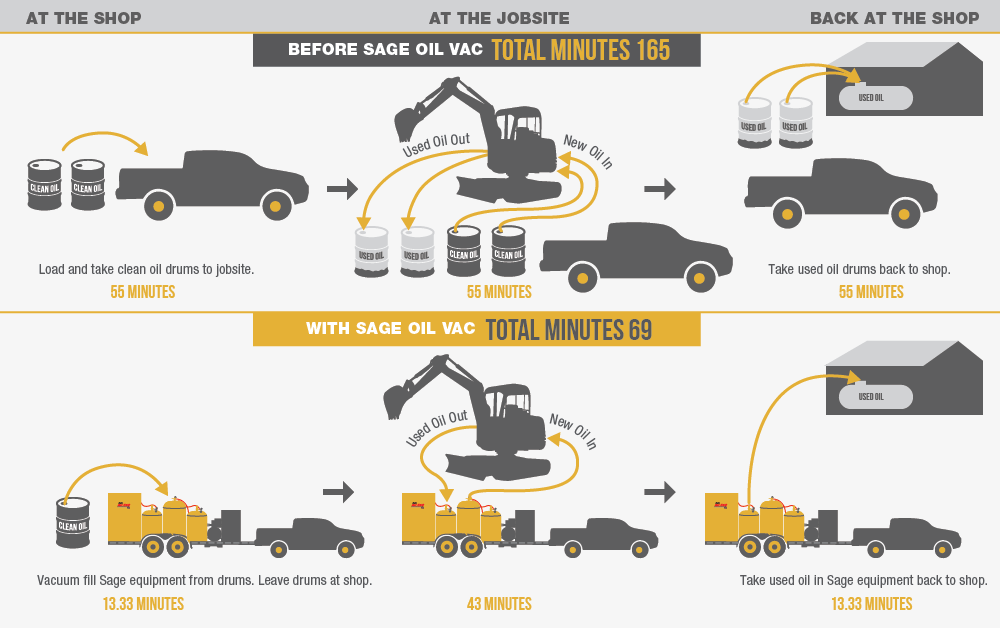
More than 250 pieces of machinery working on anywhere between 12 and 15 commercial or industrial excavation jobsites across as many as seven states. That scale of work takes a lot of resources to keep every machine operating at peak capacity.
It’s the daily reality for Port Allen, Louisiana-based Beard Construction, and that’s why Equipment Manager Lee Morrison relies on Sage Oil Vac systems. And he recently took that relationship to a new level with a customized machine that meets specific, unique needs of many of Beard Construction’s jobsites.
By the time Morrison joined the Beard Construction team in 2010, the company was already using Sage systems for mobile fluid changes. The company’s 25 – 30 job superintendents were already familiar with the benefits of using Sage systems for mobile oil changes and lubrication services on the jobsite after having previously worked with a local company to build lubrication units. As mobile maintenance requirements grew and evolved, Morrison saw a need for maintenance equipment that was simple, straightforward and efficient, but could accomplish more on each jobsite.
“Our old units were standard large tank trucks with each unit having its own oil pump. The problem with those units is there are so many pumps and there’s always a leak somewhere, or there’s an issue with the plumbing or pump itself,” Morrison said. “Sage systems are so much less problematic with no pumps, and the plumbing is virtually problem-free. They’re customizable, more compact and they really hold up well.”
Designed for specific applications
The ability to customize Sage systems is a benefit that extends well beyond basic jobsite functionality, and it’s one that Morrison is fully leveraging with the latest addition to the 15-year-old Beard Construction maintenance fleet. On top of the two multi-tank Heritage skids and their jobsite trailer currently doing services, Morrison worked with Sage Customer Service Specialist Kyle Ottmers to build the company’s latest system from the ground up. The process started with an idea and a conversation.
“I wanted a unit designed for specific applications that only had what we needed on it and nothing else,” Morrison said. “We knew the dimensions and that we needed full containment, and we got together and sketched out some drawings and came up with what would work best. With a lot of companies, you’re at their mercy, they have what they have and if you want it customized, you have to do it at your own shop. With this Sage system, we worked together and came up with the exact rig we needed.”
The process yielded a one-of-a-kind machine: By combining a Sage lube skid with a Morooka tracked vehicle, Morrison now can solve a long-standing problem on many jobsites. Working in the southern and southeastern U.S., heavy, wet soils are common on many jobs, making it difficult for operators to maneuver large, heavy service vehicles where they need to be to perform service and maintenance.
Customized machine benefits
Morrison needed a smaller, more maneuverable vehicle to get the job done. Between a Sage lube skid with a smaller physical footprint and a tracked vehicle with a 10×7-foot bed, Morrison worked with Ottmers and the Sage team to customize a maintenance vehicle with everything necessary to provide jobsite maintenance for the company’s excavators and other jobsite machinery.
“The vehicle is based on a Morooka tracked machine and a Sage lube skid. It’s not like anything we’ve ever done before. We have customized vehicles before, but this machine is unique in that it has two product tanks, a place for diesel exhaust fluid (DEF) and a place for grease,” Ottmers said. “The footprint is smaller, and the fluid containment system and different components are all pretty specialized and geared specifically to what Lee was looking for.”
The benefits of the customized machine stretch beyond productivity. It helps Morrison better manage labor, and it’s a safer, cleaner way to provide jobsite machinery maintenance.
“Some of the jobsites we got this unit for probably have $10 million worth of equipment on them. The better you can keep that equipment serviced, the more value you’ll have in it in the long run,” he said. “This machine matches our needs 100% from a labor standpoint, and it helps us achieve our No. 1 priority of safety. Everything is at an arm’s reach for the operator, and the controls are simple and easy to use. And, we’re not leaking any grease or oil on the ground. That’s huge for us since being environmentally sound is important to this company.”
Future work with Sage
Moving forward, Morrison expects the company’s next 15 years to build on the success of its first decade and a half. A big part of that growth and advancement will come in streamlining equipment and machinery to best meet the specific needs of the large-scale excavation jobs that are common for the company. Tools like Sage mobile lubrication systems will be a large part of that ongoing evolution.
“As we continue to update our fleet, I want to continually add customized systems like this to our mobile lubrication lineup so that we are working with machines that meet our direct, specific needs. Gone are the days when we will work with machines that are generic and straight off the shelf. These Sage systems are low-maintenance. We believe in quality, and quality pays.”
In addition to the utility of Sage systems on Beard Construction’s jobsites, Morrison said they have already shown promise for other areas of the business. Not only do they work more efficiently, they also provide a visual representation of Beard Construction’s innovation and attention to productivity and efficiency.
“In the long run, if you buy quality equipment, it will generally pay for itself,” Morrison said. “When we go to our large industrial clients, it’s no small bid. You are selected for these large bids based on your performance, safety, innovation and how proactive you are with how you operate and the equipment you use. These machines help us get the job done and leave a better impression with our customers.”
On the jobsite, a piece of machinery is only making you money when it’s running. Downtime — whether from unexpected breakdowns or routine maintenance — is a quick culprit of productivity and revenue loss. At the end of the day, anything you can do to keep the wheels turning and engines running will contribute to an operation’s bottom line.
Sage mobile lube systems can make a universal task quicker and more efficient, helping every machine spend more time doing its job. Like any piece of equipment on a worksite, a Sage system is designed to take care of a very specific function: Conduct lubrication and oil changes in the field. That makes it important to purchase and operate the right system to meet your specific mobile lubrication and maintenance needs with minimal work disruption, helping sustain and improve the return on investment (ROI) of machinery and equipment.
“Whether you’re moving beyond using buckets to manually change oil, driving machinery back to a shop to conduct maintenance or you’re upgrading from a different type of mobile lubrication system, a Sage system can help you keep your machinery operating by efficiently taking care of these common maintenance tasks in the field,” said Sage CEO Aaron Sage. “To maximize that efficiency, you have to match your Sage system to your specific jobsite maintenance needs.”
Here are a few things to consider in determining which Sage system is right for your operation.
Your biggest fluid management pain points: This may be the mess of manual oil changes, the time required to conduct maintenance with current methods or having the right workforce to do the job efficiently.
What you’re using to change oil now: Are you changing oil manually with buckets, or using another type of lubrication maintenance system?
Where you’re conducting maintenance: Are you changing oil and servicing machinery in a central shop or doing it on the job site?
How much machinery you’re maintaining: How many machines and different types are you maintaining?
Service frequency: How often do you change oil in the machines you service?
Maintenance services you’re providing: Are you simply topping off fluids on-site and seldom conduct full oil changes, transmission and full hydraulic exchanges, as well as 250 hour engine oil changes?
Current equipment: Do you already have trucks, skids or trailers? What is your existing payload or towing capacity?
Time on the road: How far do you travel between jobsites? How far do you travel before you make it back to the shop?
How you handle waste fluids: Do you dispose of used engine oil and other fluids in a central location? How frequently do you dispose of waste fluids?
Working conditions: Do you change oil and provide maintenance in cold temperatures that would require heated fluid tanks? Do you work best in an open or enclosed system?
Working with used oil filters: Consider ways to avoid the messiest part of the job with a Filter Stinger and used filter receptacle
Other tools and equipment: Do you have your own compressor? Do you need storage for supplemental jobsite tools and equipment?
Answering these questions about your specific operation is especially important, given the range of Sage mobile lube equipment options ranging from lube carts and skids to the largest trailers and Class 8 trucks that can provide service to multiple pieces of machinery on different jobsites. Once you know the specific improvements you want to make to your jobsite maintenance operations, it can help you know what system will work best for your business, in both the short and long term.
“Being able to identify these parts of your operation is important to your ability to select the right Sage system that can both meet your needs as well as fit in with existing equipment and processes,” Sage said. “Starting the process of integrating a Sage system — whether a lube truck, skid or trailer — into your business by having a clear picture of where you stand today can help you identify the direction to go in the future to achieve gains in productivity and efficiency that can help your business grow. We think of Sage systems as not just tools to do a job, but components of a strong growth strategy.”
Start the process to evolving your mobile lubrication services by checking out the range of Sage system options.
Growing pains always accompany periods of major business expansion. The right innovation can help streamline that growth, and for Dickinson Fleet Services that turned out to be a partnership with Sage Oil Vac.
One of the growing pains Dickinson faced was delivering oil to a large customer’s fleet. Not only would Dickinson need a much larger fleet of service trucks, but also a new level of efficiency to ensure the company continued to meet its customers’ growing needs. A decade ago, the Indianapolis, Indiana-based company had around 50 service trucks operating from nine retail locations in the Midwest and Eastern U.S.
Though the company was already poised to grow to meet its customers’ evolving needs, Dickinson’s growth and efficiency gains have come more quickly and easily in the last five years in part because of its partnership with Sage. Today, Dickinson has service technicians at locations in 38 states providing mobile truck maintenance and service, including preventative maintenance, accident damage repair and Department of Transportation inspections and certifications, with its own fleet of more than 450 service trucks. Each of those trucks uses a Sage Oil Vac system.
“Shortly after I came on board, I heard about the Sage systems and we realized they represented a safer, cleaner and overall better operating system than what we had been using in our trucks,” said Dickinson Fleet Services Vice President for Purchasing and Asset Management Don Gregory. “Sage Oil Vac systems have been a huge help in our expansion in how easily they fit into our trucks and how efficiently they enable us to operate.”
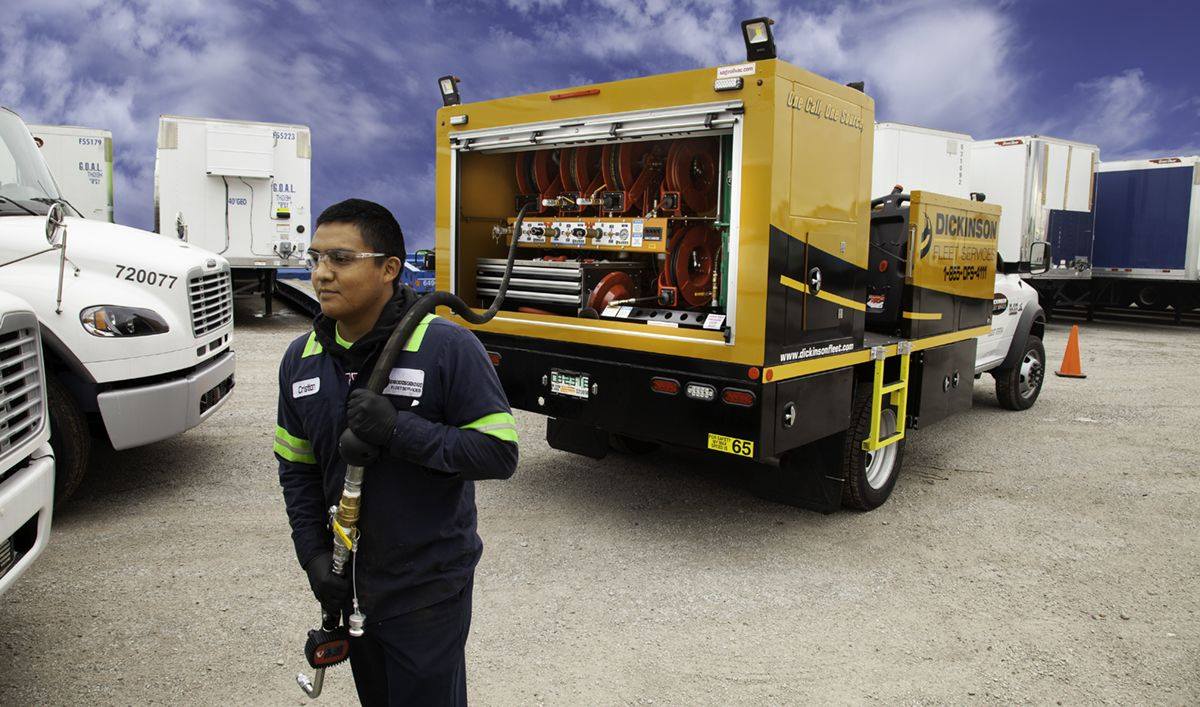
Building efficiencies with Sage
Previously, Gregory said Dickinson mobile service trucks used a pump-style system for oil change operations, and there was always lingering apprehension about pumps and tanks leaking, resulting in inefficiencies that could slow down daily operations and impede future expansion. “With Sage, I don’t worry about that at all. I feel very confident with this equipment. We don’t have issues with failing pumps and oil leaks like we did before,” he said.
Growth was already a target for Dickinson Fleet Services leadership when the company partnered with Sage Oil Vac two years ago. For Gregory, the decision to work with Sage as Dickinson’s growth continued made sense because of shared emphases on service and efficiency. Upon learning of the new efficiencies Sage systems could create for Dickinson mobile service trucks, for example, Gregory said the normal caution with which his company typically approaches new innovations quickly faded.
“We looked into Sage systems cautiously, as we do with any change. That caution went away pretty quickly with Sage. It wasn’t long after we tried their systems that we decided to integrate them into our whole fleet,” Gregory said. “They have great people, offer a great product and provide strong follow-up after the sale. They are proud of their product, you can see that pride in all of their people, and that inspires confidence in us as a partner.”
Though it’s difficult to quantify return on investment (ROI) improvements of Sage systems in Dickinson’s 450-truck mobile maintenance fleet, Gregory knows they have contributed to the company’s bottom line, both in terms of maintenance and efficiency of mobile service operations. The systems have been relatively low-maintenance since integrating them into the Dickinson fleet, and thus far Gregory has found them to be durable and long-lasting, two fundamental qualities he looks for in every new innovation to improve the company’s service vehicles.
“We are always improving our mobile trucks. We look at the overall ROI of the application of our fleet, and there has been an improvement,” he said. “We are always looking down the road because we want our equipment to last awhile, and we know that Sage systems will.”
Future growth plans
In the near future, Gregory said Dickinson will continue to improve its mobile service trucks as the company puts growing emphasis on overall fleet maintenance, not just truck maintenance, for its customers. For example, in addition to keeping up with new Sage system innovations, the Dickinson fleet is transitioning to aluminum body components. The goal: Make each service truck last a decade in the field.
“We’ve gone to an aluminum body that maintenance equipment resides inside of. We are setting a goal that every component within the box of that truck and chassis should last 10 years. We want all of our equipment to last that long. I am confident our Sage systems will last quite a while,” Gregory said. “Sage will always play a major role as we continue to refine and evolve these trucks in looking at different applications. We’re always going with Sage. I think switching to them has been one of the most strategic and smartest moves we’ve ever made.”
It’s always a good time to make sure your equipment is in top operating condition. Picture this: You’re just starting the day with a full schedule ahead and you get hit with a maintenance set back. Now, the whole day is thrown off — you might even have to reschedule a few things on the list. Whether it’s just bad luck or something you could have prevented, regular and thorough care of your equipment is the best bet for a smooth day on the job, no matter the season. Sage Oil Vac is always here to help, so we’ve compiled a list of preventative maintenance tips, tricks and advice:
In planning ahead for that busy time, it’s important to account for the machinery you’ll be maintaining and what it will need, according to Sage Oil Vac CEO Aaron Sage. “Make sure everything is serviced, including specific components like wheel bearings,” Sage said. “Ideally, you want to start the busy maintenance season with all of your machinery ready to run efficiently and without interruption.”
Don’t forget these components.
In addition to checking major mechanical and structural components, Sage said it’s important to inspect parts that many operators don’t typically think about when conducting early-season maintenance, including their Sage Oil Vac systems. “It starts with really basic maintenance, like ensuring your trailers are inspected and ready for the road,” Sage said. “The long game here is that you need to be efficient on the maintenance side.”
Equipment maintenance tips 101
Air Compressors: Your Sage Oil Vac is built to be dependable and long-lasting — this is in-part due to its very few moving parts. So, the air compressor is the most important part to keep maintained on your unit. Use the recommended maintenance schedules that come with the system for the engine and the compressor pump. An oil change on the engine and pump should be performed at least one time per year regardless of use on your system. Intake air filters should also be replaced at least one time per year.
Compressor air tanks should be drained daily during use. The Sage Oil Vac design (on some models) can result in a collection of used oil in the holding tanks that can accumulate from oil mist vacuumed into the holding tanks. This is harmless to the design of the system however, the used oil should be drained and disposed of properly to properly maintain the compressor.
Pro Tip: Operating your Sage Oil Vac continuously with the used oil tank completely full could result in a large amount of used oil accumulating within the compressor heads and air tanks. It’s important to unload the used oil tank if its capacity reaches 95 percent or before.
Ball Valves: Ball valve actuation can become loose over time and may need to be replaced. Check that that ball valve actuation on each ball valve is not so loose that they can open or close during routine travel to the jobsite.
Cam Locks: Cam lock fittings should have caps and plugs installed to reduce drips and spills. Female cam connections need to have both actuating arms intact and working to secure a good connection.
Filters: Sage units come with 10- to 25-micron fresh fluid filters for all new fluids. We recommend that these are changed two times per year or every 1,000 gallons of oil filtered.
Hose reels: Check the spring latch assembly of the hose reel to ensure that the reel is performing properly. Grease swivels should be greased at least once a year and more often for heavy use depending on the model. Double check that all ball stops are installed and tight to keep the hose reel tension in good shape.
Hoses: Sage Oil Vac uses 1,000+ psi hoses for their systems. Check the outer hose covers and look for any gouges or wear — this is especially important on spring retractable hose reels. Keep a lookout for spots where oil is seeping through the outer cover, as this could indicate that the inner lining of the hose has a rip or tear.
Hydraulic Connections: Clean off any grime or dirt from the hydraulic fittings for a secure connection to meters and equipment — any leaks should be addressed promptly.
Lug Nuts: The lug nuts on trailer wheels need to be tightened to the proper torque — this is an important responsibility that trailer owners and users need to be familiar with. Inadequate and/or inappropriate wheel nut torque (tightness) is a major reason that lug nuts loosen in service. Loose lug nuts can rapidly lead to a wheel separation and serious safety consequences.
Lug nuts are prone to loosen right after a wheel is mounted to a hub. When driving on a new or remounted wheel, check the lug nut tightness frequently during the first few hundred miles of the trailer’s use. A good rule of thumb is to check after the first 10, 25 and 50 miles of driving, before each tow, and at least twice per year thereafter.
It’s also important that you tighten lug nuts to the proper torque for the axle size on your trailer to prevent wheels from coming loose. The only way to be certain you have tightened the lug nuts properly is with a torque wrench. Four-way wrenches, ratchets and similar tools can be useful for short-term emergency repairs but they’re not appropriate tools for adequately tightening lug nuts.
While tightness is important, be warned that overtightening can result in breaking the studs or permanently deforming the mounting stud holes in the wheels. Tighten per sequence in Figure 1 below. Using this sequence, tighten all lug nuts in three stages and to the torque values listed in Figure 2 for each stage.
Pro Tip: Keep a record of the date and approximate mileage of your last torque check somewhere on or inside your equipment. Make note of any lug nut that is loose and investigate the reason(s). If the lug nut tightness is not maintained after more than one re-tightening application, this indicates there is something wrong with the lug nuts, studs, wheels and/or hubs and must be corrected.
Figure 1. Lug Tightening Sequence

Figure 2. Lug Torque Requirements

Meters: Electronic meters will occasionally need new batteries. High flow non-drip ends should be cleaned regularly to for a proper close to keep drips and spills to a minimum.
Running Lights: Make sure all brake lights, turn signals, license plate lights and market lights work correctly.
Tires: Check the condition of the tire tread, and make sure there is adequate air pressure. Also inspect for gouges or other defects.
Sage Oil Vac Tanks: The Sage Oil Vac design ensures that very little outside dirt and elements are introduced into the tanks, protecting their cleanliness, but an annual flushing of the used oil tank is recommended to flush out sludge and other contaminants that have been vacuumed out of engines and drain pans with debris. To do this, vacuum 5-10 gallons of diesel, pressurize the tank (no more than 5 psi) and dispense the fluid to flush the tank and hose circuit. This same method can be used to switch fluids in new oil tanks if necessary — i.e., switching a 15W-40 motor oil tank to a hydraulic fluid tank.
Wheel Bearings: It’s recommended to grease wheel bearings every 12 months or 12,000 miles, whichever comes first. You can use red grease for trailer wheel bearings or wheel bearing grease, which is specially designed for use on trailer running gear. Wheel bearing grease has a slightly higher temperature rating, 520 degrees, compared to 510 degrees for the red grease.
When adding grease, make sure that the new is compatible with the old or remove the old grease completely. Incompatible greases can break each other down. Also, inspect the bearings and races before repacking them and replace the grease seals since they will likely be damaged in the process.
Consider equipment accessories for increased efficiency.
After you’ve inspected your equipment and ensured it’s ready for the jobsite, it’s a good time to consider any changes or additions you can make to become more efficient. That may mean adding new machinery or making smaller changes. For example, Sage said adding new drain plugs and hose assemblies can make oil changes cleaner and more efficient, especially when used alongside a Sage Oil Vac system.
“Once your machinery is ready to go, it’s a good time to start looking at a system to enable you to connect directly to machines for changing oil, making it cleaner and more efficient,” Sage said. “Cleaner drain plugs like those from Femco® work well with Sage Oil Vac systems and can make you better at your job of changing oil on the jobsite.”
Plan your maintenance operations.
Early in the busy season is a good time to look at ways you can streamline not just your equipment, but how you use it. Extended oil changes have been a growing trend in the automotive industry for some time now, and it’s starting to work its way into the construction sector. While it may work for some equipment, waiting longer between oil changes isn’t feasible for all machinery, largely because of working conditions. Prioritizing oil change jobs based on frequency and need is one way to make your operations more efficient.
“The deciding factor on that is the work environment. Is it a dirty environment? How hard is the machinery working? If it’s dirty and the machinery’s working hard, you can’t really delay oil changes,” Sage said. “If it’s an over-the-road truck that’s getting a lot of hours on it, but in cleaner working conditions at the same RPM for long periods, extended oil changes will work. If it’s an excavator ramping RPM up and down, working out in dirt storms and getting worked really hard, you need to monitor oil a lot more closely and keep oil changes more frequent.”
Regular maintenance is essential to keep equipment, accessories and your work environment safe and reliable. Do not hesitate to contact your Sage Oil Vac Dealer for any maintenance and equipment questions.
Our Sage Oil Vac dealer network is what makes us who we are today, and we wouldn’t be playing such a major role in our customers’ success if not for the men and women who sell and service Sage Oil Vac systems and equipment around the U.S. That’s why it’s important to us to give much-deserved “shout-outs” to the dealers who go beyond the call of duty in the criteria that make for a successful dealership, including participation in dealer marketing programs, product knowledge, promotional activity and year-over-year sales growth.
Platinum Award — Perfection Truck Equipment
Perfection Truck Equipment has come a long way in the over 70 years since starting out with nine employees and five truck lines. Today, the Oklahoma City, Oklahoma-based company supports more than 120 lines of trucks and 100 lines of truck and trailer mounted equipment primarily for the oil/gas and construction industries. The team at Perfection Truck Equipment has more than a century of combined experience in sales and service for the trucking industry, and a key component of that success recently has been the addition of Sage Oil Vac LubeBuilder and Lube Truck sales and service. They’ve been a valuable partner in a major geography for Sage Oil Vac, getting the Sage name in front of new customers while providing industry-leading service for existing ones.
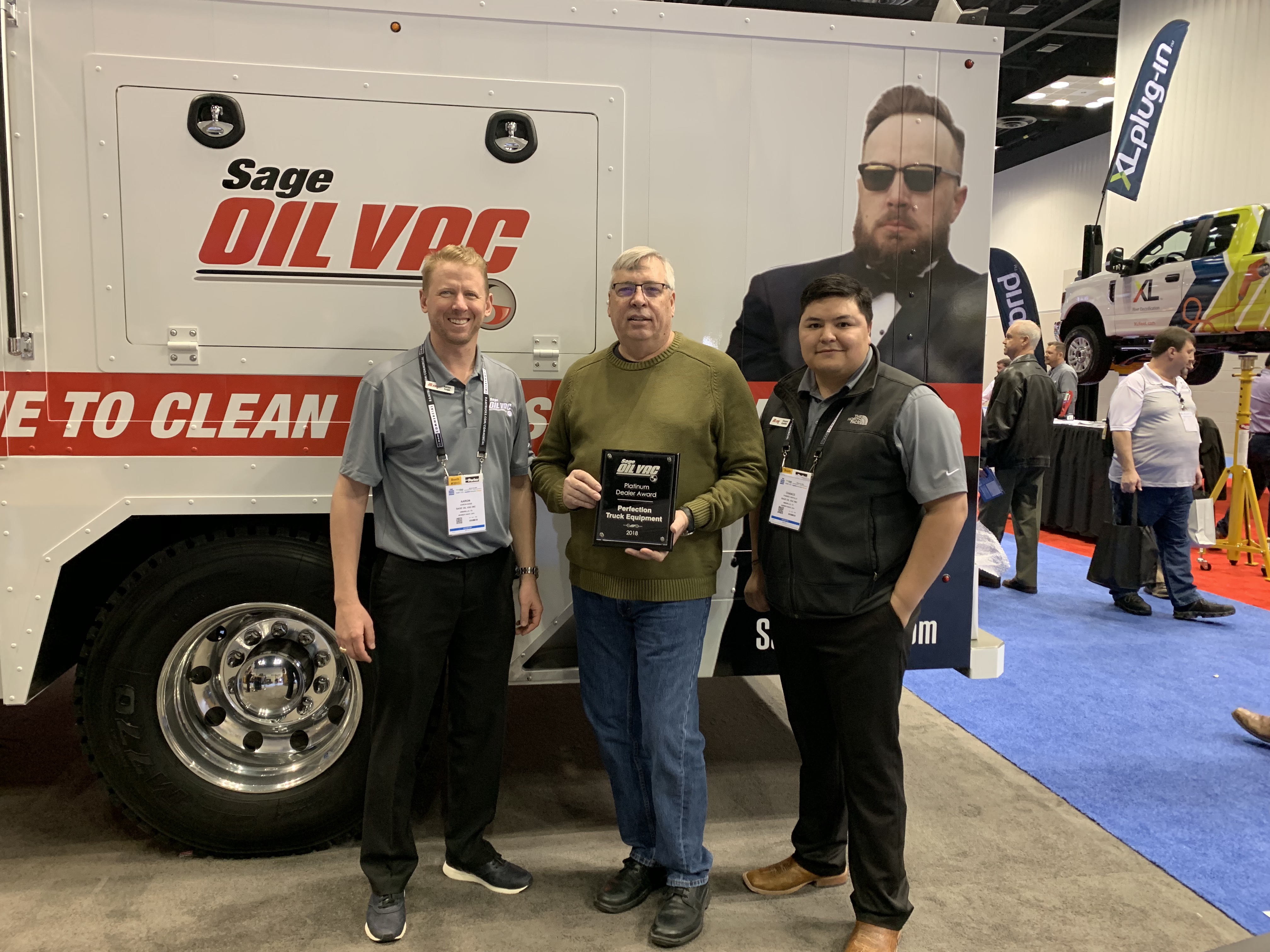
Gold Award — ACME Truck Body
Construction and generator maintenance are the primary markets for ACME Truck Body in Vero Beach, Florida. Sage Oil Vac Lube Trucks and LubeBuilder systems are important in enabling ACME ‘s customers to do their jobs. And, Mark Steinberg at ACME Truck Body has become one of the leading sales and service providers for Sage systems since becoming part of our dealer network. They are true “go-getters” with sales and service who have helped expand the Sage customer base in the Florida construction industry marketplace.
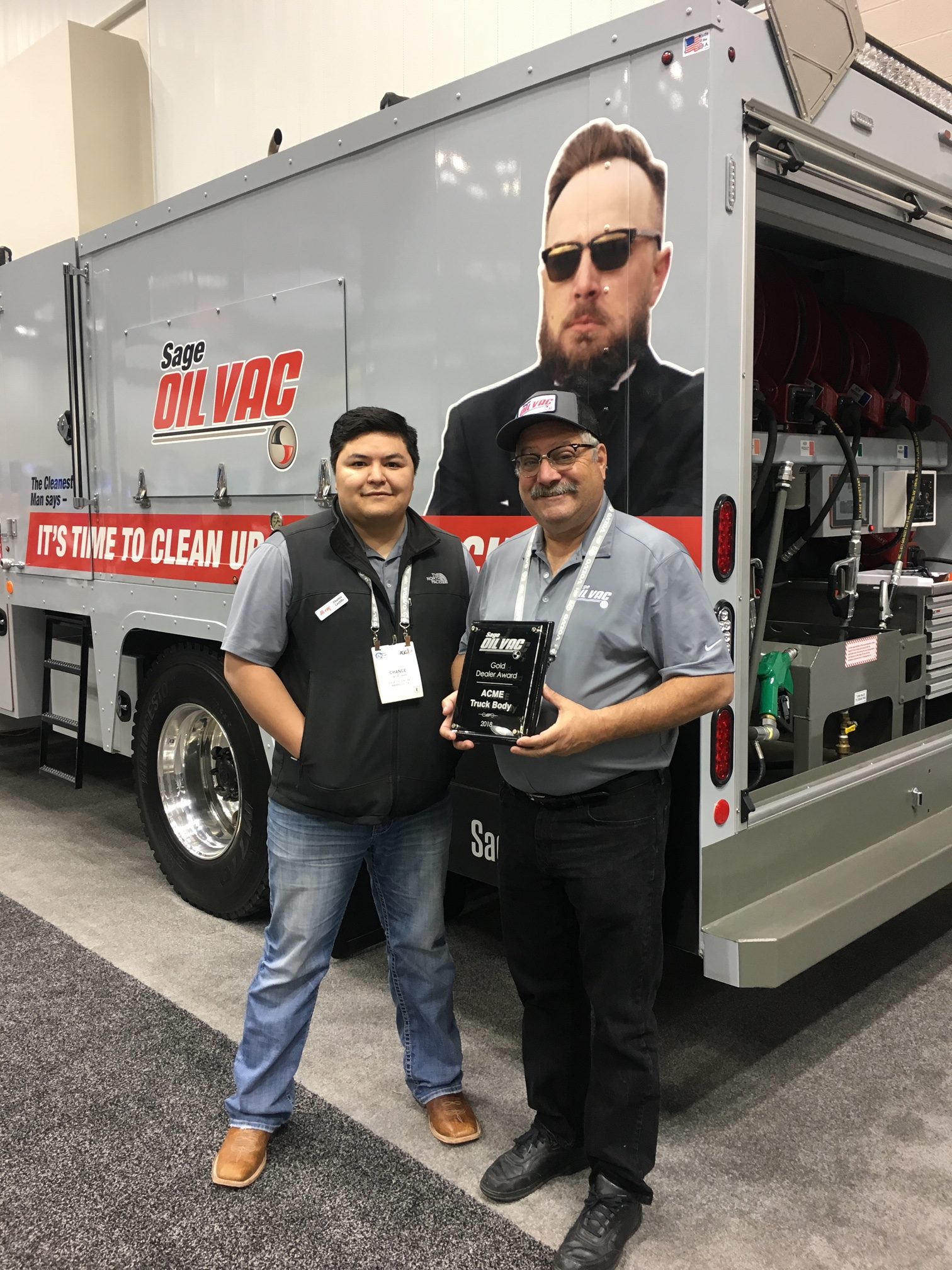
Silver Award — Oil Patch Power
Dwayne Green has been working in the oil field business for a long time and has a lot of expertise. So, when he wanted to take his company, Midland, Texas-based Oil Patch Power to the next level five years ago, he became a Sage Oil Vac partner. Today, he’s among the nation’s leaders in Sage lube skids and lube system sales and service around the Permian Basin oil field across parts of Texas, Oklahoma and New Mexico. In addition to being one of the top Sage dealers in the country, Green has helped refine the Sage product line and leverages his co-op funds for advertising and trade shows around the Permian Basin region.
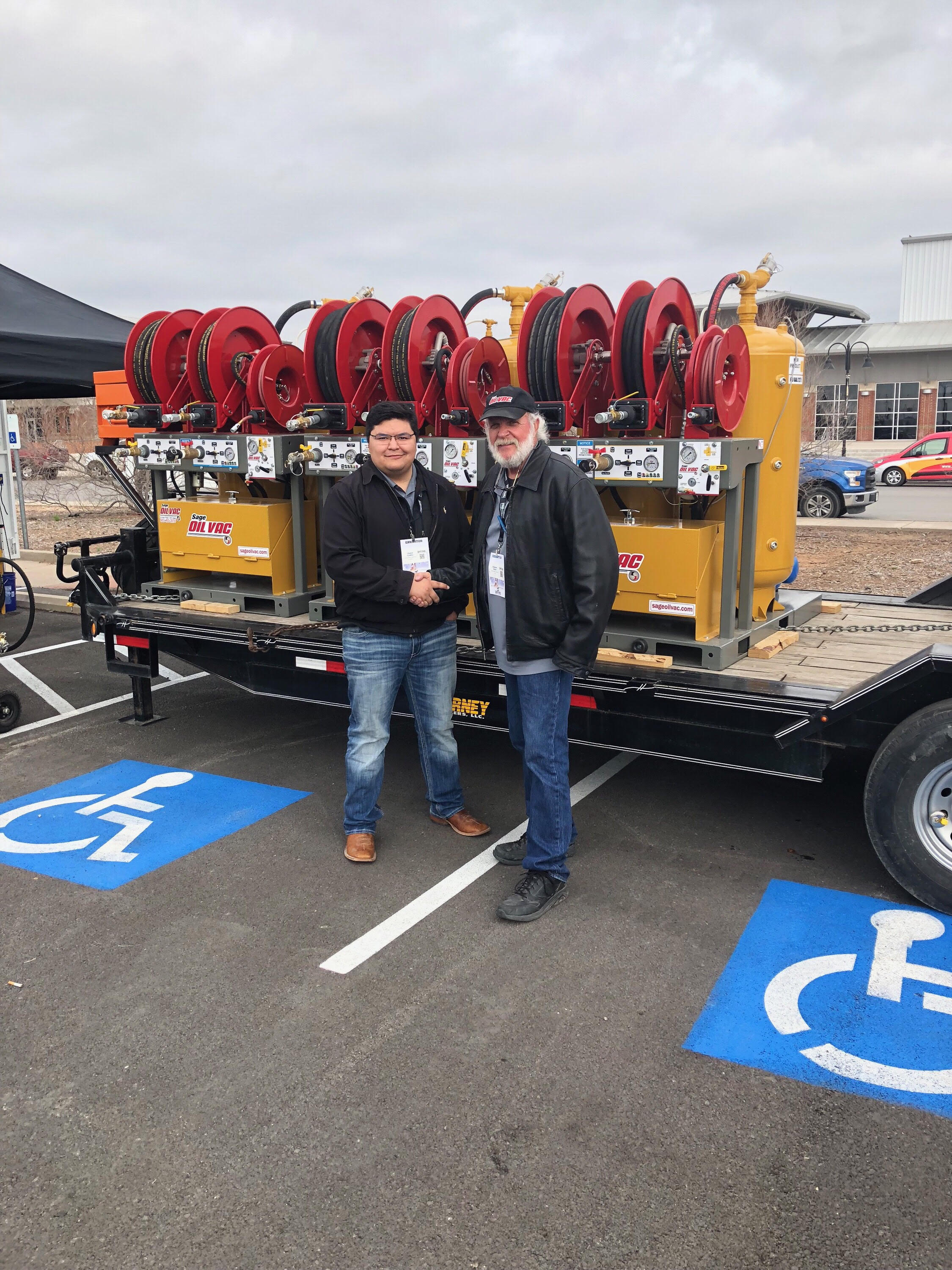
Outstanding New Dealer Award — Utility Equipment Service
When the folks at Utility Equipment Service in Spring Hill, Tennessee, were looking for a new product line to offer their customers in the construction and generator maintenance industries, they found Sage lube skids and trailers to be the perfect fit with their existing products and services. The team at Utility Equipment Service provides a wide array of construction equipment, work trucks and accessories, and are constantly working hard to evolve so they continue to surpass their customers’ expectations with the most up-to-date equipment sales and service. Their work ethic and ability to showcase Sage equipment are just a couple of reasons why they’re our Outstanding New Dealer for 2018.
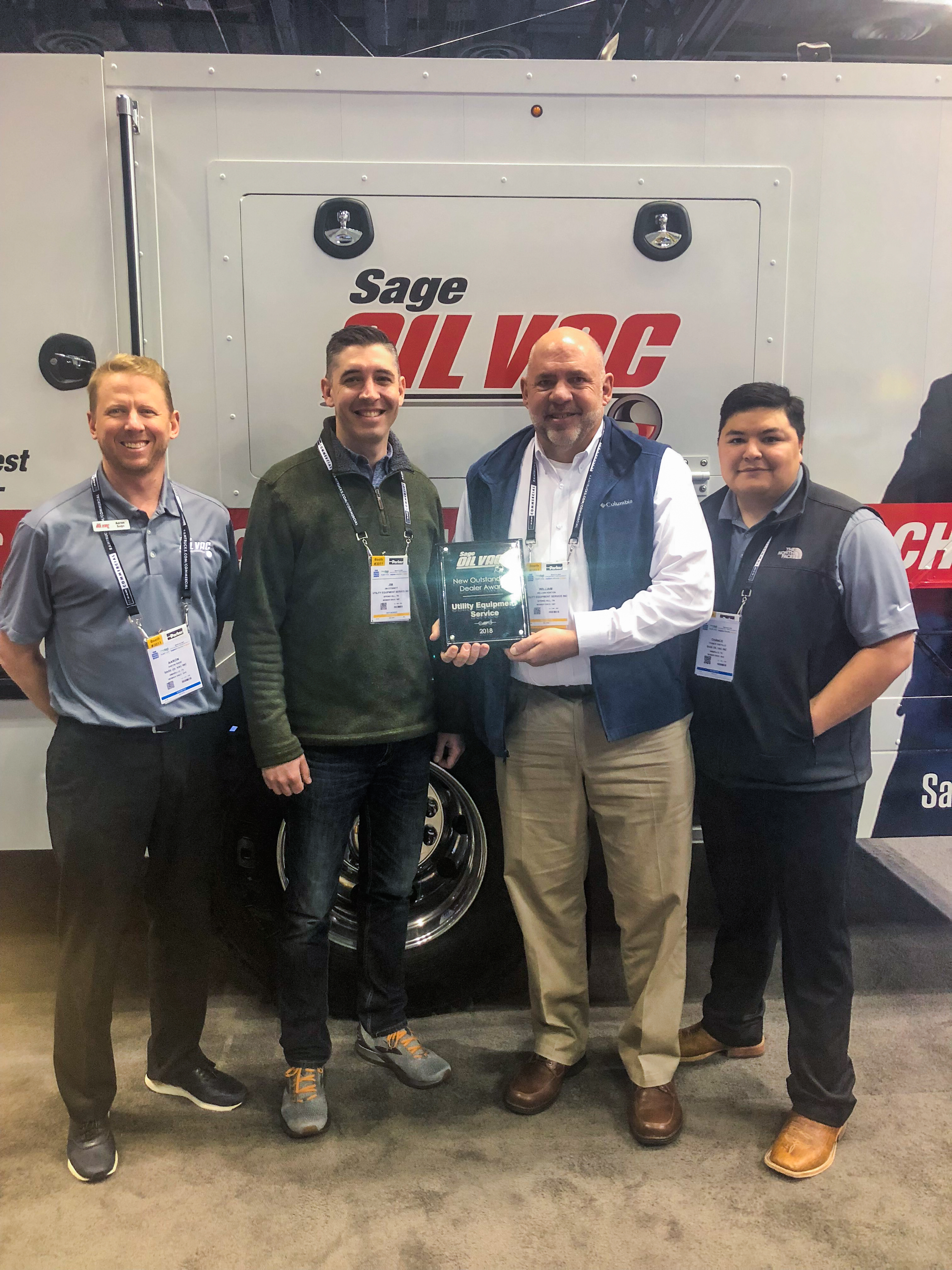
Thank you to the entire team of Sage Oil Vac dealers, congratulations on another great year, and here’s to continued success in the future!
Service after the sale is a top priority for most contractors when investing in a piece of construction equipment, and can be what separates a quality equipment dealer from its competition. How quickly a service technician has a machine up and running after a breakdown or after doing routine preventative maintenance work is how most contractors gauge equipment dealers. So, to score high marks with customers, dealerships need to hire knowledgeable service technicians and equip them with everything they need to be efficient in the field.
Ditch Witch Sales of Michigan understands that its customers depend on them. With locations in Grandville and Howell, the two service techs for the dealership spend almost 100 percent of their time in the field performing routine maintenance and handling emergency service calls when the need arises. Homer Gonzalez, from the Grandville Ditch Witch Sales of Michigan location, is one of the technicians. His job has him traveling all over the state and working on a wide range of equipment. 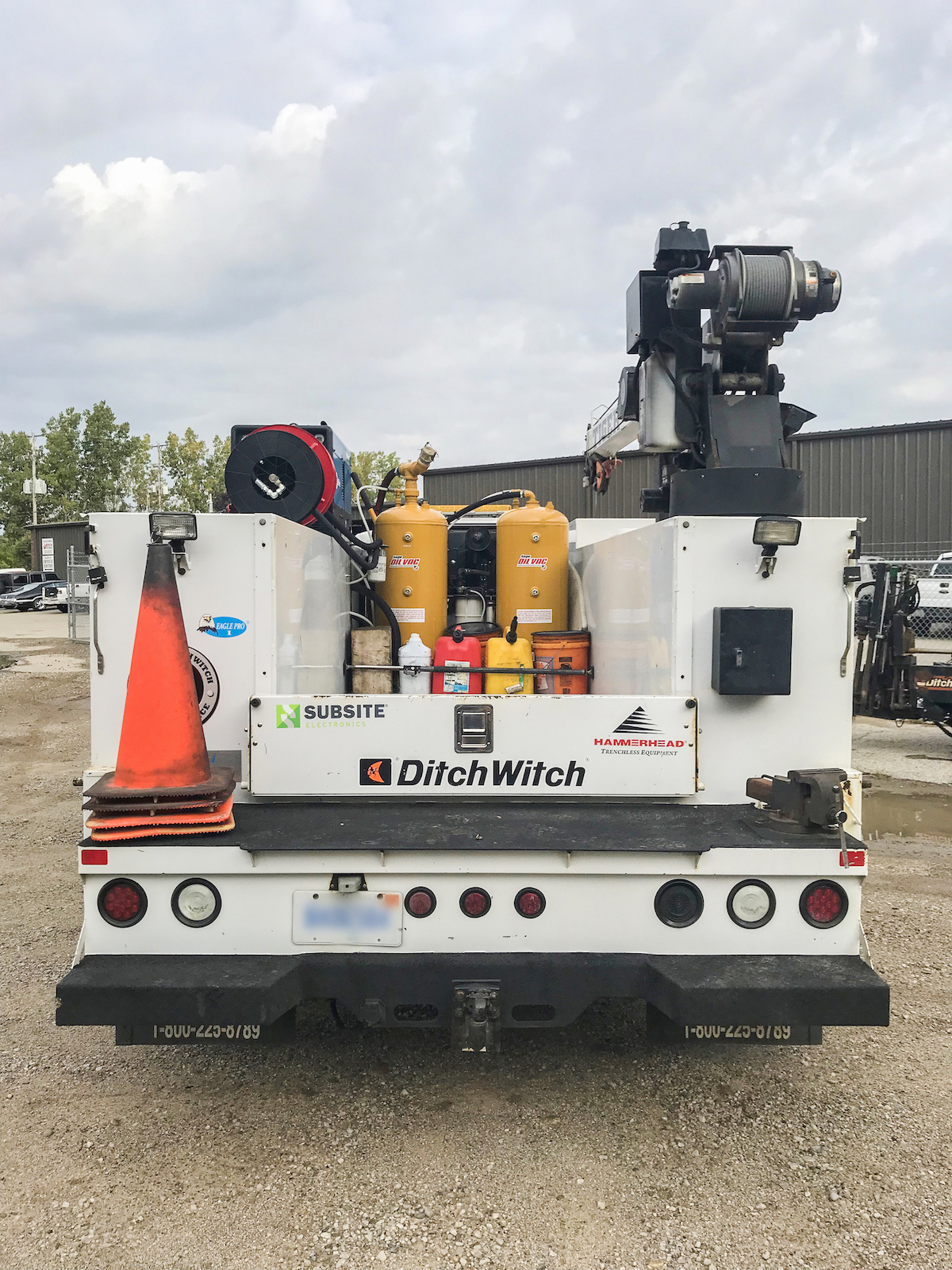
“I was a service tech in the oil fields before going to work for the dealership, Gonzalez explained. “I enjoy the work. I get to visit a lot of jobsites and work on a lot of different machines. And while a large chunk of the work is doing routine maintenance things like oil changes, there are times where a machine goes down and I need to work as quickly as possible to get it working so customers can stay on schedule. It’s those times, where the parts and tools I have on my truck make a difference.”
Officing from the truck
Just like anyone in the construction industry, Gonzalez’s Ford 550-truck is his office, and he is incredibly strategic about how he uses every square inch. Its service box is outfitted with a service crane, welder and air compressor. The side compartments house tools, supplies and parts.
“I believe keeping everything organized, clean, and tidy is one of the keys to being a good field service technician,” Gonzalez said. “However, until recently keeping the bed of my truck that way was a real challenge because I was devoting so much space to hauling around buckets of fresh and used oil. A person can do their best to make sure they wipe up drips on the buckets before putting them back in, but as they bounce around on a rough road and shift while turning, you’re bound to have some leakage.”
Transporting buckets wasn’t the only issue that the Ditch Witch Sales of Michigan service technician ran into while performing routine oil changes. He also said that having buckets sitting around a machine and wiping oil drips up was creating an unprofessional image. He knew there had to be a better, more efficient, way of handling these fluids.
Discovering a more efficient mobile lube solution
Gonzalez’s quest to come up with a better mobile lubrication solution, and perhaps the desire to go home at night with clean hands, lead him to Hoekstra Truck Equipment, a Sage Oil Vac dealer in Grand Rapids, Michigan to see what the company’s options were for adding a mobile lube system to their service fleet.
“While working in the oil field, there were a lot of companies that used large mobile lube service trucks or trailers, but I wasn’t sure if anyone offered a system that could be fitted to an existing truck without taking up the entire bed,” Gonzalez explained. “Mike Thorsen with Hoekstra showed me a Sage Oil Vac mobile lube system and explained how their compressed air fluid exchange systems use vacuum technology to dispense fresh fluids and suction up waste fluids using an air compressor. He also told me that I could create my own customized system based on my needs and the space I had available in my truck. It sounded like a great solution to my problem.”
After consulting with Thorsen and the team at Sage Oil Vac, the Ditch Witch service technician decided to order a Sage LubeBuilder system with two 30 gallon tanks. He planned to dispense fresh oil from one of the tanks and dispose of waste oil in the other.
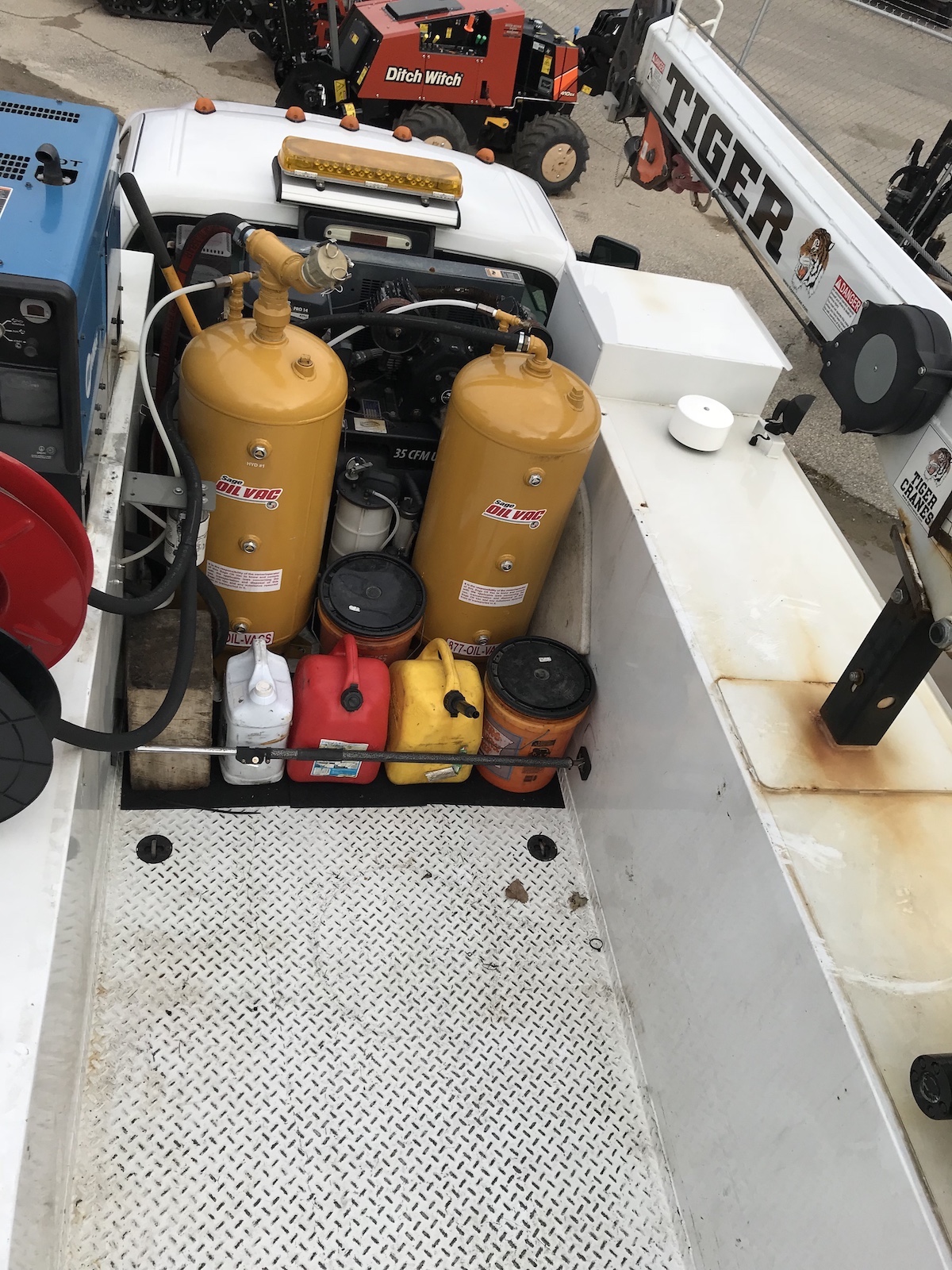
Installing the system
Sage Oil Vac designed its LubeBuilder System to be easy to install and highly customizable. Gonzalez received tanks, hoses, reels, control panels and all of the accessories needed to perform the install himself. “Sage Oil Vac provided easy to understand instructions and diagrams for installing the system in the back of my truck. The whole process took about 8 hours and was pretty easy. I probably could have wrapped it up faster, but I’m pretty particular about my truck so I took a bit longer,” he added.
Gonzalez mounted the two storage tanks toward the front of the truck bed, mounted the controls to a panel near a compartment near the cab and the two reels are mounted on the top of the gearbox. The truck’s existing air compressor powers the whole system. Between the two tanks, the service tech has created a small area to hold used filters and accessories.
Efficient operations
Since making the switch to a custom mobile lube system by Sage Oil Vac, Gonzalez estimates he’s been able to reduce the time it takes to service customer equipment by as much as 40 percent. Not carrying around buckets and drip pains has also freed up a significant amount of his truck bed, and replenishing his supply of fresh fluids and disposing of waste oil is also much easier.
“On the job, there’s no longer any wasted time wiping down buckets,” Gonzalez said. “Also, there is little chance of contaminants getting into the fresh oil because I’m using a closed system when I’m adding oil to my onboard tank and when I’m on the jobsite replenishing a machine’s fluids. The chance of spilling any oil on a jobsite is also greatly reduced. There isn’t any downside to using a system like this — only positives.”
With all of the efficiencies created by adding a custom mobile lube system to its Grandville service truck, Ditch Witch Sales of Michigan went ahead and ordered another LubeBuilder system for the service truck at its Howell location. Gonzalez said that he was able to help with the install and it was ready to go in less than six hours this time.
“Equipping our trucks with a mobile lube system frees up a lot of time during our week, which means we can be more responsive to our customers’ needs. And, the system we chose is perfect because it’s customizable, so we don’t waste any space on our service trucks,” Gonzalez concluded.

